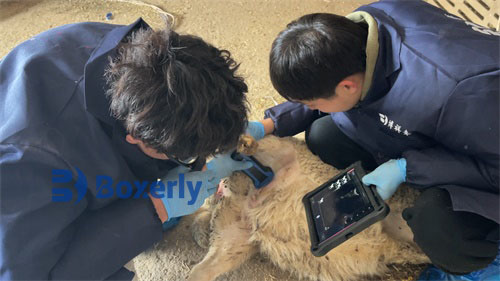Pregnant sows are best kept in a single pen. The pen surface should be flat, dry and clean, and the ground should not be too slippery to prevent falls. Use pig B-ultrasound to check their condition frequently.
In the early stage of pregnancy, sows should eat well and sleep well, prevent changing pens, mixed group fighting, not be driven away, reduce exercise, and keep the environment quiet to prevent mechanical stimulation; but in the middle of pregnancy, they should exercise more appropriately; in the later stage, the amount of exercise should be reduced, sows should be allowed to move freely, and activities should be stopped one week before delivery.
Exercise should be stopped in rainy, snowy or too cold weather to prevent slipping or abortion caused by violent contraction of the uterus due to freezing. Whipping is strictly prohibited, crossing the ditch and gate slowly, and crowding, rapid driving, sharp turns, etc.
Pig B-ultrasound observation, if there are signs of abortion, progesterone should be injected in time. Cooling measures should be taken and sufficient clean drinking water should be provided. Especially in early pregnancy (3-18d) and late pregnancy (102d-parturition), sows are particularly sensitive to high temperatures. Try to cool down or take measures to make sows feel intermittent coolness. Prevent various diseases in time, especially those with elevated body temperature, which are easy to cause stillbirth. Use pig ultrasound for observation frequently. Immunization: It is best to avoid vaccination within 40d of pregnancy, especially inactivated vaccines; generally, 3-4 weeks before delivery is suitable for most vaccines. Avoid using embryotoxic drugs within 40d of pregnancy. For example, florfenicol has obvious reproductive toxicity, which can cause embryo malformation and early embryo death. Pig ultrasound Boar induction method. One is to use test estrus boars to chase and climb non-estrus sows, which can induce them to estrus and ovulate. This method is still more effective when observed by pig ultrasound. The second is to play boar courtship tapes, and the effect of using biological simulation is also very good. Merge non-estrus sows into the estrus sow pen, and promote their estrus and ovulation through stimulation such as climbing, and the effect can be observed by pig ultrasound. For sows that are not in estrus, outdoor exercise, sunbathing, and fresh air can promote their estrus and ovulation. If combined with grazing, the effect will be better. For sows that are not in estrus, massaging the breasts for 10 minutes every morning can promote their estrus and ovulation. During the treatment process, it can be observed by pig B-ultrasound.
Drug treatment. Pregnant mare serum (PMSG), human chorionic gonadotropin (HCG), estrogen and testosterone can promote estrus and ovulation of sows. After these drugs are injected, the effect can be seen by pig B-ultrasound observation.
The period from weaning of piglets to estrus and mating of lactating sows is the empty period. In a broad sense, it also includes reserve sows to the age of first mating. The purpose of raising empty sows is to maintain normal breeding body condition. Through pig B-ultrasound observation, they can be observed to be in estrus and ovulate normally, and can be mated and conceived in time. The feeding and management of empty-stomach sows is also related to the benefits of the pig farm. The extension of empty-stomach time not only causes economic losses, but also disrupts the production cycle. During this period, young sows should be encouraged to estrus early, ovulate frequently, and breed early to achieve the goal of multiple births and high production. For weaned sows or non-pregnant sows, take active measures to organize breeding and shorten the empty-stomach time.
When sows reach sexual maturity, they will have an inherent sexual activity cycle, also known as the estrus cycle. The interval from the last estrus to the next estrus is usually called the estrus cycle. The average estrus cycle of a sow is 21 days, ranging from 19-24 days.








